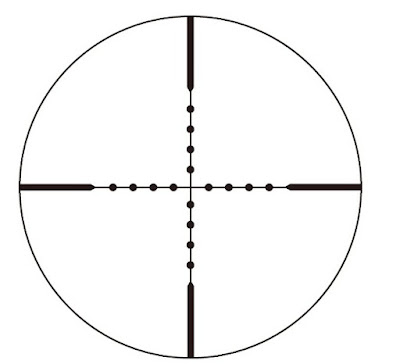Imagine you're a sniper (or hunter, or golfer, or surveyor), to do your job you need know the distance from yourself to some far off point. To get this value, you'd probably reach for your high tech laser, infrared or sonic rangefinder. But what if you're rangefinder's batteries are dead or the device damaged? All isn't lost, as you're probably using an optic that includes a ticked-crosshair like this:
Those dots aren't just for decoration, they are designed for estimating distance. This method is known as stadiametric range finding, and it works by having the viewer plug two values into a math formula. The values are the actual height or width of an object in the scene, and the number of ticks the object takes up in the scope. For example, if you know there's a 5'6" (1.67 meters) person in the scene, and this person takes up 3.5 ticks in your mil-dot scope, then you know that you are approximately ((1.67 x 1000) / 3.5), or 477 meters away from that person.
This method is handy because you don't need a special piece of tech to use it. The optic you are already schlepping around can have this built in. There's nothing extra to carry, break or forget.
What interested me however, was whether it's possible to use this same technique without an optic. Whether in a wilderness or urban setting, being able to estimate distances would be a handy skill. I can't, however, justify carrying around a mil-dot monocular on the off chance I'll want to measure a distance.
The good news is that you can absolutely do stadiametric range finding without magnification. The range-r-card by Black Hill Designs does exactly this. You hold the plastic card in front of you, and estimate distance using the same principle as a mil dot reticle.
While more purpose built, the Dead On Range Finder does the same thing. The Dead On is used by bow hunters, and on the surface doesn't look anything like a sniper's scope or range-r-card. However, the principle remains the same: you know an object's size in the scene (the average belly height of a deer), an observed size of this object and therefore, an approximate distance.
This type of range finding isn't new. Back in the 1800's when soldiers switched from muskets to rifles they found themselves with both an opportunity and a challenge. Rifles had a much larger range than muskets, but one could only take advantage of this if you could properly estimate the distance to your target. The December 1st, 1869 edition of the North Iowa times gave this grim prediction if the challenge of fast and accurate range finding was ever solved:
An Italian officer is reported to have made a discovery, by means of which any private soldier is enabled to measure the distance of any object within range, instantly, and at the same time to aim a gun or canon with unerring accuracy. This would make all firearms such murderous weapons, that two detachments of troops within range would be enabled to utterly destroy one another.
During the Civil War, the US issued stadia to select soldiers as a means of doing, you guessed it, primitive stadiametric range finding.
The Civil War stadia, like the range-r-card, works by holding the device at just the right distance from your eye by having the operator bite down on, and extend a cord. When an enemy soldier fills up a marked section of the stadia, you effortlessly know his distance.
While both the range-r-card and 19th century stadia replica are relatively cheap and compact, I was curious if it was possible to DIY a solution from gear that I already carry. That way, I won't have to take up space on a purpose built item that will get used infrequently.
Stay tuned, I'm planning to tackle that challenge next.




No comments:
Post a Comment